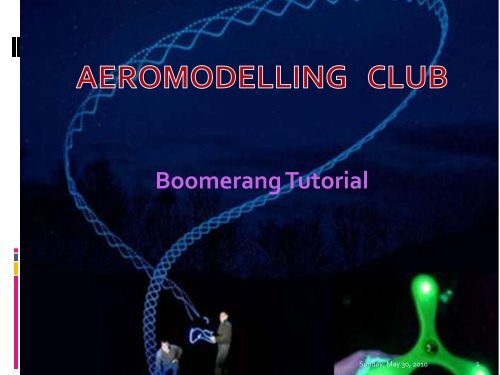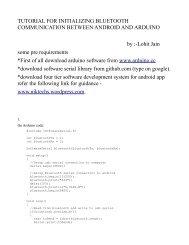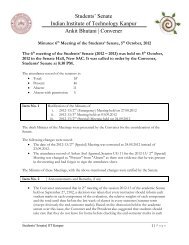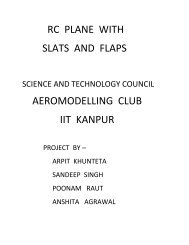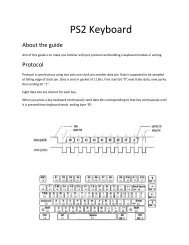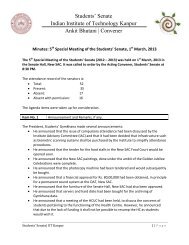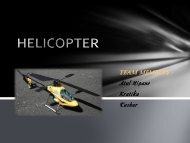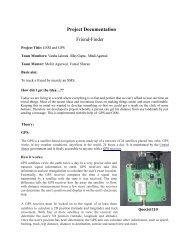Boomerang Tutorial
Boomerang Tutorial
Boomerang Tutorial
Create successful ePaper yourself
Turn your PDF publications into a flip-book with our unique Google optimized e-Paper software.
<strong>Boomerang</strong> <strong>Tutorial</strong><br />
Sunday, May 30, 2010<br />
1
OUTLINE<br />
Slide No.<br />
• What is boomerang ? 3<br />
• History of boomerang. 4<br />
• Features of boomerang. 5<br />
• Aerodynamics of boomerang. 8<br />
• Physics of boomerang. 12<br />
• Material used. 20<br />
• Throwing techniques. 21<br />
• Flight problems & solution 32<br />
• Some innovative shapes & design 38<br />
• Sources 39<br />
Sunday, May 30, 2010<br />
2
What is boomerang?<br />
It is a bent or curved piece of tough wood (or<br />
any other material), which can be thrown so as<br />
to return back to the thrower.<br />
It is a scientific marvel as it envisions<br />
the aerodynamic as well as aviation<br />
principles coupled with theorems<br />
of Physics which were surprisingly<br />
utilized thousands of years before they were<br />
even invented.<br />
Sunday, May 30, 2010<br />
3
History of boomerang<br />
• With a history of being 30,000 years old, it is<br />
believed to be the oldest flying object.<br />
• Prominently used by Australian aborigines as<br />
hunting sticks (kylies) which were nonreturnable.<br />
• Now over years it had been<br />
developed as a recreational object<br />
kylies<br />
Sunday, May 30, 2010<br />
4
Features of boomerang<br />
• <strong>Boomerang</strong> has a<br />
leading edge and a<br />
trailing edge<br />
• Returning<br />
boomerangs consists<br />
of two or more arms<br />
connected at an<br />
angle<br />
• Each arm is shaped as<br />
an airfoil<br />
Sunday, May 30, 2010<br />
5
Sunday, May 30, 2010<br />
6
Sunday, May 30, 2010<br />
7
Aerodynamics of boomerang<br />
How does a boomerang float in the air?<br />
The same aviation principle. The wing of an airplane<br />
is designed in such a way that at the topside the wind<br />
speed is much more greater than at the bottom side.<br />
The result- Because of the very high velocity of wind<br />
at the topside of the wing, the pressure is small and<br />
at the same time since the velocity of wind at the<br />
bottom side of the wing is much less, the<br />
pressure is great which pushes the wing up.<br />
Sunday, May 30, 2010 8
• 1. Leading shock wave front. Fluid doesn't "feel" airfoil and airfoil doesn't feel fluid on left 1-A-1 line.<br />
2. Fluid pillow: the area of increased dynamic pressure. The streams generation starts here.<br />
3. Streams. The envelope of the streams corresponds to theBoundary area. It is assumed that stream having less<br />
than 5 percent of stream maximum speed can be neglected. The threshold option permits to hide very slow<br />
streams in trailing edge, which do not affect airfoil lift, but are responsible for energy dissipation only.<br />
4. Trailing edge of shock wave. Streams separate from trailing edge of airfoil near 4-C-4 line. The separation relaxes<br />
stress, which generates the trailing edge shock wave. No lift force is generated on right side of this line. The right<br />
(CD) area corresponds to stream tension relaxation and the region of their inertive energy dissipation.<br />
5. Reduced pressure air bubble increases airfoil drag, but has no effects on the lift force. It starts at a separation<br />
point and follows the airfoil, sucking fluid from the nearest streams. The bubble corresponds the turbulent region.<br />
Sunday, May 30, 2010 9
<strong>Boomerang</strong> basically acts on The Bernoulli’s<br />
principle<br />
How does a boomerang return to the<br />
thrower?<br />
When you throw a boomerang you not only impart<br />
great speed but also a certain amount of spin. The<br />
spin at the top is more than at the bottom. Because<br />
the design enables the top of the wing to move<br />
forward and at the same time spin forward as well,<br />
for the same reason, the bottom portion spins not<br />
very fast but it surges forward and effects the lift.<br />
Sunday, May 30, 2010 10
Topside spins forward – backside spins backward.<br />
Result? When the boomerang loses momentum<br />
the spin creates a gyroscopic precession, which<br />
propels it to turn to the left enabling it to fly back<br />
in a circle to whoever threw it.<br />
Sunday, May 30, 2010 11
Physics of boomerang<br />
• A boomerang does funny things because it is<br />
in fact a gyroscope. Aerodynamic forces<br />
generate a twisting moment which cause the<br />
"gyroscope" to precess and to move on a<br />
circular path.<br />
• However, to understand what precession is,<br />
you simply need to observe that as well as<br />
spinning quickly round its own axis, the<br />
boomerang slowly changes the direction in<br />
which it is pointing.<br />
Sunday, May 30, 2010 12
• Examining the forces acting on a boomerang of<br />
radius a. The centre of the boomerang is moving at<br />
a constant forward speed V and the boomerang is<br />
spinning with angular velocity ω, as shown in the<br />
diagram.<br />
The "top" end A is<br />
therefore moving<br />
faster than with<br />
speed “V+aω”, and<br />
the "bottom" end B<br />
is moving slower<br />
with speed “V-aω”.<br />
Sunday, May 30, 2010 13
A wing generates more lift when it is moving<br />
faster so point A is generating more lift than<br />
point B.<br />
The two forces F A and F B can be represented<br />
by a single force and a single couple C. With<br />
this simple representation of the forces<br />
acting on the boomerang we can give two<br />
reasons why it moves on a circular path:<br />
Sunday, May 30, 2010 14
1. A constant centripetal force F produces<br />
circular motion with velocity on a radius<br />
such that:<br />
F = mV 2 /R (1)<br />
where m is the mass of the boomerang.<br />
2. A constant couple C acting on a gyroscope<br />
spinning at angular velocity ω causes steady<br />
precession at rate Ω such that:<br />
C = JωΩ (2)<br />
where m is the mass of the boomerang and J<br />
is its moment of inertia.<br />
Sunday, May 30, 2010 15
If the rate of precession Ω exactly<br />
corresponds to the angular velocity<br />
of circular motion, then the<br />
boomerang rotates at exactly the<br />
correct rate to stay tangential to the<br />
flight path as shown. This gives an<br />
equation relating V to Ω,<br />
V = RΩ (3)<br />
A wing of area A moving at speed v in air with density<br />
ρ generates an aerodynamic lift force L. It can be<br />
shown that L is proportional to the air density, the<br />
wing area and the square of the wing speed.<br />
Sunday, May 30, 2010 16
The precise relationship is expressed using the<br />
proportionality constant C L , which is known as<br />
the lift coefficient, and takes the following form:<br />
L = ½ ρv 2 C L A (4)<br />
It can also be shown by integrating the lift force<br />
over the area of a cross-shaped boomerang that<br />
the net lift force and aerodynamic couple are<br />
given by<br />
and<br />
F = ¼ ρ(V 2 + (aω 2 )) C L A S (5)<br />
C = ¼ ρV 2 aωC L A S (6)<br />
Sunday, May 30, 2010 17
For the case of a cross-shaped boomerang,<br />
where V, ω and a are the velocity, spin speed<br />
and radius of the boomerang as before, and<br />
A S = πa 2 (the swept area of the boomerang).<br />
, and equations 1, 5 and 7 can be arranged to give<br />
From equations 2, 3 and 6, we find that the<br />
radius R of the circular flight path is<br />
independent of spin speed ω and forward<br />
velocity V, and that it is a constant for a given<br />
boomerang:<br />
R = (4J) / (ρC L πa 4 ) (7)<br />
Sunday, May 30, 2010 18
• For the case of a boomerang with J=1/3 ma 2 ,<br />
and equations 1, 5 and 7 can be arranged to<br />
give<br />
aω = (√2) V (8)<br />
which defines the "flick-of-the-wrist" needed<br />
to make the boomerang fly properly.<br />
Sunday, May 30, 2010 19
Material used<br />
• <strong>Boomerang</strong>s are made with materials such as wood<br />
(mostly birch or poplar), from hard woods like teak<br />
or rosewood exceptionally crafted to get the body<br />
weight and balance. Today, plastics, reinforced<br />
fiberglass, polypropylene, PVC, ABS (Acrylonitrite<br />
Butadien Styrol), Paxolin (made of layers of paper<br />
bonded with phenolic resin) etc are also used.<br />
However, a precision crafted boomerang made<br />
from birch wood still steals the thunder!<br />
Sunday, May 30, 2010<br />
20
Throwing technique<br />
• Right-handers must use right-handed<br />
boomerangs and vice-versa<br />
Right-handed<br />
Dingle Arm Grip<br />
Right-handed<br />
LIft Arm Grip<br />
Sunday, May 30, 2010<br />
21
Left-handed<br />
Dingle Arm Grip<br />
Left-handed<br />
Lift Arm Grip<br />
• You must always grip the boomerang so that<br />
the curved side is toward you and the flat<br />
side should face away from you. (In flight, the<br />
curved side is the top and the flat side is the<br />
bottom.) You can grip the boomerang by<br />
either the dingle arm or the lift arm.<br />
Sunday, May 30, 2010<br />
22
Choose a grip that is comfortable for<br />
you<br />
• Pinch Grip: Make your hand into a<br />
hitchhiking sign, and then pinch the<br />
boomerang tightly between your<br />
thumb and first finger.<br />
• Pencil Grip: Support the boomerang<br />
with your thumb, first finger, and<br />
middle finger as shown. The first<br />
finger hooks around the edge of the<br />
boomerang.<br />
Sunday, May 30, 2010<br />
23
• <strong>Boomerang</strong>s are thrown overhand, not sidearm!<br />
The boomerang should be released vertically<br />
(perpendicular to the ground).The layover from<br />
vertical should be no more than 5-20°. Upon<br />
release, the boomerang should cartwheel<br />
forward, end over end, in a nearly vertical plane.<br />
Sunday, May 30, 2010<br />
24
• It is extremely important to avoid using too<br />
much layover. If the boomerang is thrown with<br />
too much layover and released too horizontally,<br />
it will spin like a frisbee, suddenly climb high into<br />
the air, and then dive straight into the ground.<br />
<strong>Boomerang</strong>s may break when thrown in this<br />
way.<br />
Face the wind directly. Then<br />
turn to the right about<br />
45°away from wind if you<br />
are right handed and viceversa<br />
Sunday, May 30, 2010<br />
25
1. Aim a little above the horizon.<br />
2. Cock your arm back over your<br />
shoulder, with your wrist bent<br />
backwards. Follow through with a smooth body<br />
motion and a strong snap of the wrist. The snap will<br />
create spin, and spin is more important than power.<br />
Grip tightly throughout the throw and release. The<br />
boomerang will pull itself out of your grip.<br />
3. Be sure that the boomerang is released in a<br />
nearly vertical plane. Do not throw<br />
horizontally (sidearm).<br />
Sunday, May 30, 2010<br />
26
In windy conditions (over 5<br />
MPH), boomerangs tend to fly<br />
over your head and past you.<br />
Four things should be followed:<br />
1. Try throwing softer.<br />
2. Throw with less layover<br />
3. Throw higher.<br />
Usually a combination of two<br />
serves good.<br />
Sunday, May 30, 2010<br />
27
After you are familiar with the<br />
flight pattern of your boomerang,<br />
you can attempt catching.<br />
However, never try to catch plummeting<br />
boomerangs, or boomerangs that are returning<br />
rapidly, or higher than chest level. The trick in<br />
catching is to make a "boomerang sandwich." Hold<br />
one hand above and one below, with palms parallel<br />
to the boomerang. As the boomerang floats<br />
between them, slap your hands together.<br />
Sunday, May 30, 2010<br />
28
1. Hold boomerang facing the wind, nearly vertical<br />
with flat side 1 away 2 from you. Then 3 turn about<br />
45° to the right if you are right-handed, or<br />
about 45° to the left if you are left-handed.<br />
2. Cock arm back, with wrist bent backwards, aim.<br />
3. Throw with snap of the wrist, releasing the<br />
boomerang in a vertical plane at a point just<br />
above the horizon.<br />
Sunday, May 30, 2010<br />
29
Throwing in wind (Details)<br />
• There are four basic ways to deal with wind:<br />
1. East throw, or "surfing throw" : Impart lot of spin with snap<br />
of wrist without providing much forward velocity which will<br />
be eventually provided by wind. Also release it higher with<br />
more layover than usual. Its least effective among all four.<br />
2. Humpback throw : Throw with vertical release, high altitude<br />
and hard throw. It works because boomerang loses forward<br />
velocity as it tries to crash into ground.<br />
3. Drag producing additions that slow the boomerang down<br />
thus preventing it from flying past your head. You can do so<br />
by drilling holes, more and closer to tips or by placing taped<br />
flaps whose location should be experimented accordingly.<br />
4. Adding weight by placing coins with tape accordingly.<br />
Sunday, May 30, 2010<br />
30
o Conclusion: When throwing in wind it is helpful<br />
to understand that boomerangs don't come back<br />
very accurately. And when you do flap, weight, or<br />
throw the boomerang just right, and it comes<br />
back accurately, it is very satisfying.<br />
The key to learning how to throw in wind, is to<br />
go out and throw in wind! Simple as that. Try<br />
flaps, weights, humpbacks and surfing. The best<br />
solution is probably a combination of one or<br />
more these techniques.<br />
Sunday, May 30, 2010 31
Flight problems & solutions<br />
TOO FAR AWAY FROM THE WIND<br />
TOO MUCH INTO THE WIND<br />
• Problem: <strong>Boomerang</strong><br />
circles but lands in front<br />
of you.<br />
• Solution: Throw more<br />
directly into the wind.<br />
• Problem: <strong>Boomerang</strong><br />
circles but lands in back<br />
of you.<br />
• Solution: Throw more<br />
away from the wind.<br />
Sunday, May 30, 2010 32
• Problem: <strong>Boomerang</strong><br />
circles but returns short.<br />
• Solution: Throw harder,<br />
or use more spin.<br />
TOO SOFT<br />
TOO HARD<br />
• Problem: <strong>Boomerang</strong><br />
flies high over your<br />
head and past you.<br />
• Solution: Throw easier,<br />
or release the<br />
boomerang in a more<br />
vertical position.<br />
Sunday, May 30, 2010 33
TOO MUCH LAYOVER<br />
• Problem: <strong>Boomerang</strong> climbs straight up and<br />
then dives to the ground. This is THE most<br />
common problem.<br />
• Solution: <strong>Boomerang</strong> was released too<br />
horizontally (sidearm). It should be nearly<br />
vertical when released.<br />
Sunday, May 30, 2010 34
TOO LITTLE LAYOVER<br />
• Problem: <strong>Boomerang</strong> dips in flight, and may hit<br />
the ground.<br />
• Solution: <strong>Boomerang</strong> was thrown with too<br />
little layover. Throw with a little more layover.<br />
Sunday, May 30, 2010 35
TOO HIGH<br />
• Problem: After being thrown into the air,<br />
boomerang fails to circle and crashes to the<br />
ground.<br />
• Solution: <strong>Boomerang</strong> was thrown too high.<br />
Throw boomerang lower. Aim at a point just<br />
above the horizon.<br />
Sunday, May 30, 2010 36
FLAT SIDE FACING IN<br />
• Problem: <strong>Boomerang</strong> fails to climb into the air, hits<br />
the ground and cartwheels.<br />
• Solution: 1. <strong>Boomerang</strong> was gripped with the flat<br />
side towards you. Turn the flat side away.<br />
OR<br />
2. You threw the wrong-handed boomerang. Throw<br />
the correct left-handed/right-handed boomerang.<br />
Sunday, May 30, 2010 37
Some innovative shapes and designs<br />
Sunday, May 30, 2010 38
Sources<br />
• Wikipedia<br />
• Google images<br />
• Google<br />
• Bing<br />
• Yahoo<br />
Sunday, May 30, 2010 39
THANK YOU<br />
Sunday, May 30, 2010 40


